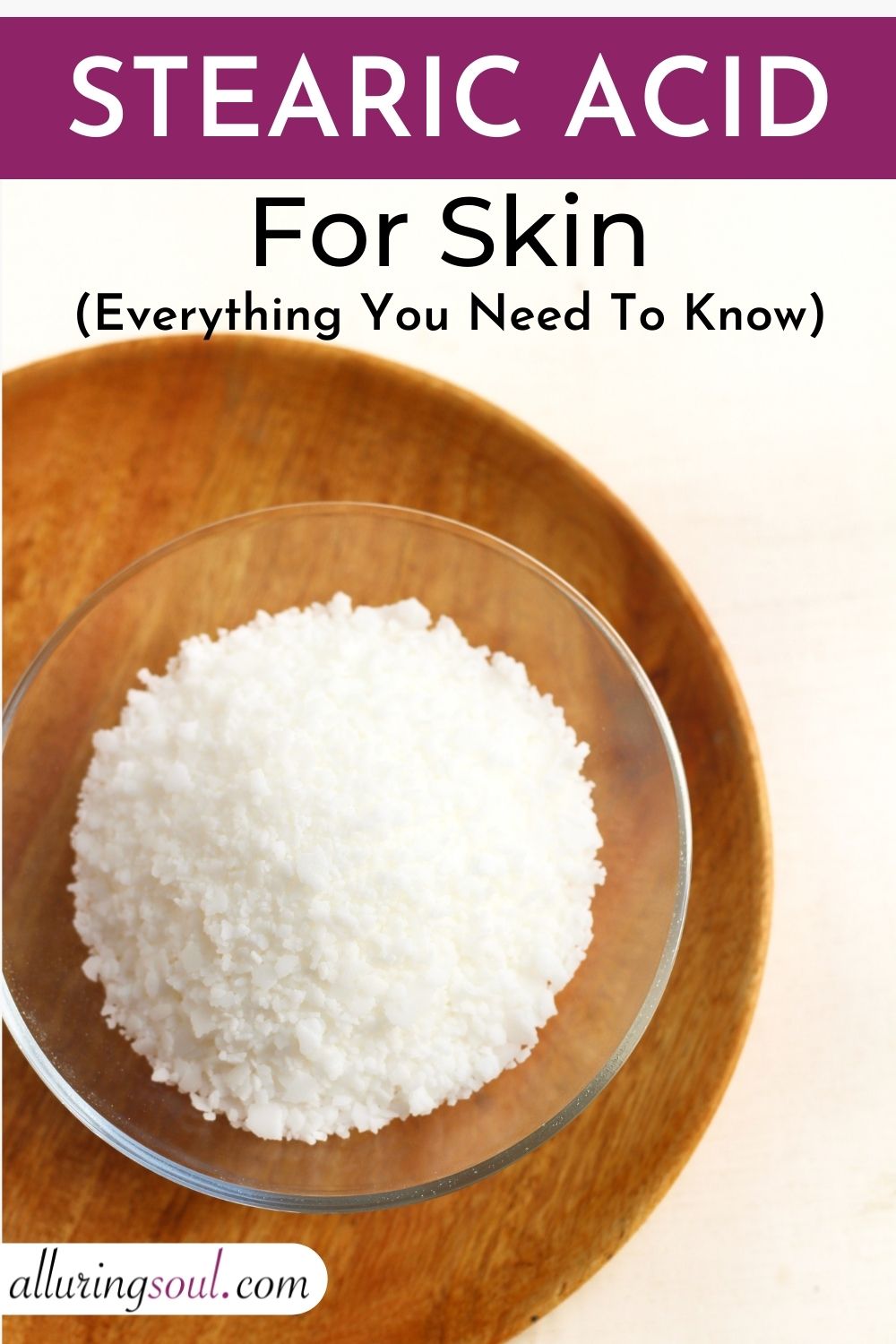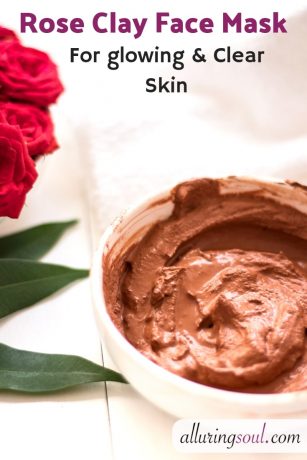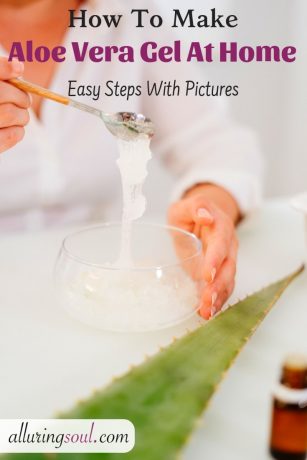Stearic acid is a chemical compound derived from vegetable fats and works as a product thickener like lotions and creams. Stearic acid is popularly derived from coconut. It doesn’t have a significant odor, hence finds use in various cosmetics.
Let us get into more details regarding what is stearic acid and what are its benefits.
What Is Stearic Acid?
Stearic acid is used as a product thickener or hardener in making lotions, creams, body butter, salves, and emulsified body scrubs. It is found in waxy white flakes or pellets. Stearic acid is a fatty acid derived from vegetable fats such as soybean, or cottonseed oil. Hydrogenation of these oils results in stearic acid. Animal fats can also be employed in their manufacture.
Usage Rate – Stearic acid is added at 1% – 25% of the final weight of the formulation. The lower amounts are used for oil and water emulsions and higher amounts are typically used for anhydrous products like a salve, body butter, or emulsified scrubs.
Solubility – Stearic acid is soluble in oil and is added to the heated oil phase of the formulation.
Stearic acid is a naturally derived chemical compound that confers softness and moisture if used in cosmetics. It is a skin-friendly product, thus, can be used for formulating sensitive and dry skin products. Stearic acid provides a soft texture and adequate soaping effect, naturally soothing the area where the product is applied. Due to its emulsifying properties, this ingredient allows water and oil to mix effectively, giving it a velvety texture.
What Are The Benefits Of Stearic Acid For Skin?
1. Stearic Acid Works As A Co-emulsifier And Helps To Stabilize Emulsion.
Stearic acid plays a key role in holding the various components of a product together.
Water and oil-based ingredients tend to separate in the formulation. Stearic acid helps to keep them mixed and prevents the splitting or separating of ingredients. This helps to stabilize the product.
2. Stearic Acid Helps To Thicken The Products & Adds Body And texture To Products.
Stearic acid helps to thicken or harden the formulations and provides a smooth and creamy texture to formulations. Stearic acid is used in small amounts (1–4%) in lotions and it will significantly thicken them. When stearic acid is used in products like cleansing balms or emulsified sugar scrubs, it thickens without the weight and waxiness of waxes.
3. Stearic Acid Has A Cleansing effect.
Stearic acid helps to remove oils and fats and suspend dirt, allowing them to be washed away due to its cleansing property. It works like surfactants to attract the oil & dirt and wash them away. Due to these properties, stearic acid forms an important component of several cleansers and body washes.
4. Stearic Acid Helps To Moisturize Skin.
Stearic acid is a natural emollient. It works similar to other ingredients like jojoba oil, Shea butter, or Vitamin E. It makes the region of the application feel soft and smooth.
Stearic acid has various properties that are beneficial for the skin. It confers anti-aging protection to the skin surface and does not clog pores. These are safe for sensitive skin and have no associated side effects. Moreover, it serves the purpose of a cleanser while protecting the natural form of your skin. All these properties make it an ideal ingredient for cosmetics.
Is Stearic Acid Natural?
Yes, stearic acid is natural. It is derived from plant and animal fats and can either be used alone in products or combined with other ingredients. It is a natural raw material.
Does Stearic Acid Clog Skin Pores?
No, stearic acid does not clog pores, which is one of the factors that makes it ideal for acne-prone skin.
What Does Stearic Acid Do To The Skin?
Stearic acid has multiple roles that are essential for skincare. It adds moisture, protection, and reduces wrinkle formation on the skin. This ingredient eliminates impurities and prevents skin irritation.
Is Stearic Acid Harmful To Sensitive Skin?
No, it does not harm sensitive skin as they play the role of protecting the skin layer and does not interfere with the natural form of the skin.
Is Stearic Acid Vegan?
You can derive stearic acid from both plant and animal fats. Plant-based stearic acid can be used as a vegan alternative. So products containing plant-based stearic can be labeled as vegan.
Is Stearic Acid Soluble In Water?
No, stearic acid is insoluble in water. It is soluble in oils and can be added to the heated oil phase of the formulation.
Is Stearic Acid Bad For Oily Skin?
No, stearic acid is not bad for oily skin. Based on experts’ study, stearic acid does not interfere with the natural oils present on the skin, unlike other ingredients that remove all the oils.
Is Stearic Acid Good In Making Lotion And Creams?
Yes, stearic acid is good for making lotions and creams because it helps to harden the product and works as a co-emulsifier. A co-emulsifier helps to bind the water and oil together and helps to stabilize the product.
Is Stearic Acid Good For Hair?
Yes, stearic acid is good for hair. You can find stearic acid in many haircare products. Based on its property of forming a moisturizing layer, it covers the hair shaft giving it a smooth outer appearance. This role is effective in formulating conditioners.
Is Stearic Acid Good For Scrubs?
Yes, stearic acid is good for making emulsifying scrubs. Along with its emulsifying and cleansing properties, stearic acid gives a body to the scrub and provides better results and feel for your skin.
Table Showing Properties Of Stearic Acid –
| STEARIC ACID | |
| What is stearic acid? | Stearic acid is a chemical compound derived from animal and vegetable fats. Stearic acid is manufactured from vegetable oils such as soybean, or cottonseed oil. Hydrogenation of these oils results in stearic acid. |
| Appearance | It is found in waxy white flakes or beads form. |
| Texture | Stearic acid provides a soft texture and adequate soaping effect to the product. |
| Solubility | Stearic acid is soluble in oil. Add it to the heated oil phase of the formulation. |
| Usage rate | 1% – 25% |
| Is it safe for sensitive skin? | Yes, it is safe for sensitive skin as they play the role of protecting the skin layer and does not interfere with the natural form of the skin. |
| Is it natural? | It is a natural raw material derived from plant and animal fats. |
| Does it clog pores? | No, stearic acid does not clog pores. |
| Best for skin types | Stearic acid is good for all skin types. |
| Is it vegan? | Products containing plant-based stearic can be labeled as vegan. |
| Benefits for skin and hair | 1. Stabilizes products. 2. Acts as a co-emulsifier. 3. Cleans the skin without drying it. 4. Moisturizes the skin. 5. Do not clog pores. 6. Eliminates the itchiness of the skin. |





No Comments